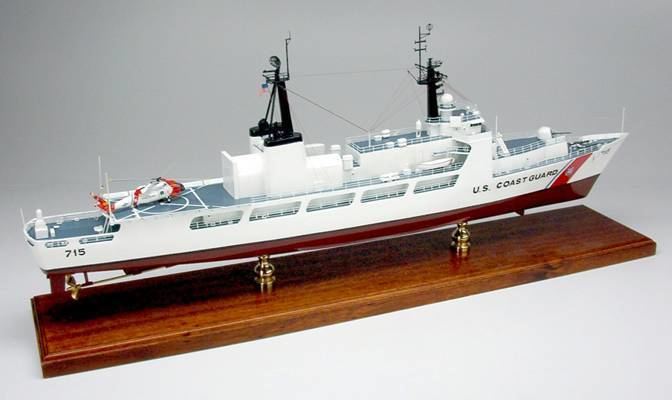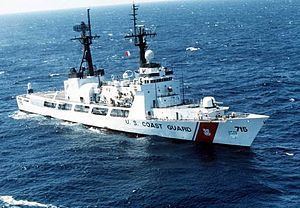Commissioned March 18, 1967 Beam 43 ft (13 m) Length 115 m Displacement 2.948 million kg Endurance 1.5 months | Decommissioned March 28, 2011 Launched 18 December 1965 Weight 3,302 tons Range 25.928 million m Builder Avondale Shipyard | |
 | ||
Motto Semper Primus(Always First) Fate Decommissioned and transferred as an Excess Defense Article to the Philippines as BRP Gregorio del Pilar (PF-15) Propulsion | ||
USCGC Hamilton (WHEC-715) was a US Coast Guard high endurance cutter and the lead ship of its class. Hamilton was based in Boston MA from commissioning until 1991 and then out of San Diego, California. Launched December 18, 1965 at Avondale Shipyards near New Orleans, Louisiana and named for Alexander Hamilton, the first United States Secretary of the Treasury and founder of the United States Revenue Cutter Service. She was commissioned March 18, 1967.
Contents

USCGC Hamilton was decommissioned on March 28, 2011 and transferred to the Philippine Navy as an excess defense article under the Foreign Assistance Act on May 13, 2011 as BRP Gregorio del Pilar (PF-15).
Design

The Coast Guard designed a high level of habitability into Hamilton. Living compartments and areas provide fairly comfortable accommodations, including air conditioning, for the 173 men and women who serve on board.
Propulsion

Hamilton was the first U.S. military vessel to employ the now common shipboard application of aircraft gas turbine jet engines with the use of controllable pitch propellers. Hamilton's two 18,000 horsepower (13,000 kW) Pratt & Whitney gas turbines can propel Hamilton at speeds up to 28 knots (52 km/h). Hamilton also has two 3,500 horsepower (2,600 kW) Fairbanks-Morse diesel engines, capable of driving the ship economically at 17 knots (31 km/h) for up to 14,400 nautical miles (26,700 km) without refueling. A retractable/rotatable bow propulsion unit provides exceptional maneuverability in tight situations.
Flight Support

Hamilton's flight deck and hangar, capable of handling both Coast Guard and Navy helicopters extends the vessel’s rescue and maritime law enforcement operations.
Renovation
In 1988, Hamilton completed a three-year fleet renovation and modernization that provided the ship with modern weapons and electronics systems. All spaces and machinery were also completely overhauled and refurbished. The new technology enables Hamilton to operate seamlessly with the United States Navy.
Missions
Hamilton has served a variety of missions with distinction. During a 1969-70 deployment to Vietnam, Hamilton interdicted weapons smugglers and fired more than 4,600 rounds of gunfire in support of U.S. and Vietnamese troops ashore. From 1965-1975, Hamilton served on Atlantic Ocean Stations, collecting valuable oceanographic data and conducting frequent search and rescue missions. Hamilton also directed the interdictions of over 21,000 Haitian migrants throughout the Caribbean during Operation Able Manner. In 1994, Hamilton received the Coast Guard Meritorious Unit Commendation for rescuing 135 Haitians from the sea after their sailboat capsized and sank. In 1996, Hamilton transited the Panama Canal and served as the command and control platform for Operation Frontier Shield, a multi-agency effort to curtail the influx of narcotics into the United States. Hamilton intercepted 14 drug-laden vessels carrying more than 115 tons of contraband worth 200 million dollars. In 1999, Hamilton seized over 2,700 kilograms of cocaine bound for the U.S. in the Eastern Pacific Ocean. Hamilton frequently patrols the Bering Sea off the Alaskan coast at the Maritime Boundary Line (MBL) which separates the Russian and the United States' Exclusive Economic Zones (EEZ). Hamilton's presence on the MBL deters foreign fishing vessels from fishing in the U.S. EEZ.
In March 2007, Hamilton assisted the Sherman in the largest recorded maritime drug bust in history. The two vessels intercepted the Panamanian-flagged fishing vessel Gatun in international waters and were able to recover 20 metric tons of cocaine, with an estimated street value of $600 million retail. The seizure was the largest drug bust in US history and the largest interdiction at sea.
Additional
The U.S. Navy League Cadet Corps (NLCC) has a unit commissioned named after the USCGC Hamilton. The units name is Training Ship Hamilton located in San Pedro, CA.
